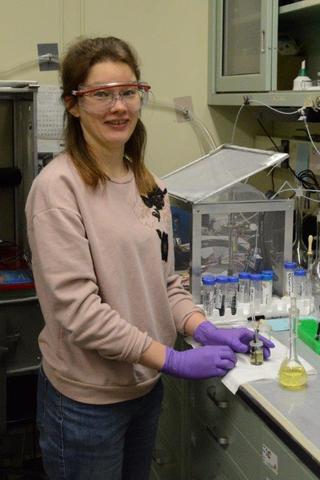
Dr. Nicole L. Ritzert is pictured in her ADA lab.
The interagency research, which has led to dental products such as tooth-colored composites, the front surface dental mirror, the panoramic x-ray machine, dental adhesives, and the high-speed handpiece, continues strong into this year.
In April 2019, NIST renewed an almost century-long partnership with the American Dental Association (ADA) through a new cooperative research and development agreement (CRADA). The CRADA is a key component of the strong foundation which the interagency relationship is built upon. ADA and NIST employees work together on NIST’s Gaithersburg campus in the Dr. Anthony Volpe Research Center (VRC), which was renamed in September 2013 to honor now-retired Anthony Volpe, DDS, MS for his long-time commitment to dental research.
NIST’s relationship with ADA first began back in 1928 when ADA sent one of their scientists to work in NBS’s Research Unit developing standards for dental materials. The center focuses on translational research, using knowledge from basic sciences to develop materials and tools that address critical medical needs in dentists and clinicians’ offices. The projects under VRC focus on dental subject areas ranging from materials science to antimicrobial materials. More recently, research areas including oral sensors and additive manufacturing have emerged.
Dr. Nicole Ritzert, a former postdoc at NIST, is one of the many ADA scientists working at VRC. She is the ADA project leader, alongside NIST lead Dr. Tom Moffat, of the oral biosensors project. Along with Dr. Shinae Kim, another ADA project leader, her research focuses on the development of in-mouth sensors for dental caries and periodontal disease.
Through the partnership, ADA and NIST work together toward common goals that address measurement challenges in dental research and materials science. “By sharing expertise and equipment, both partners are able to accomplish more than if we were working separately,” says Dr. Ritzert, when asked about the benefits of the CRADA.
Her background in electrochemistry allows Dr. Ritzert to provide invaluable expertise in the building of small electrodes used in oral sensors in the VRC and in electrodeposition measurements performed at NIST in Dr. Moffat’s group. In addition to shared expertise, the CRADA facilitates the sharing of resources and facilities. “VRC scientists work with NIST staff in the NanoFab to fabricate nano- and micrometer size electronic circuits used in sensors as well as with NIST researchers in the Material Science and Engineering Division to study additive manufacturing,” said Dr. Ritzert. NIST employees also conduct research in the ADA Labs and use their state-of-the-art tools.
Dr. Ritzert cited the technology transfer seminars hosted by NIST’s Technology Partnership Office (TPO) as beneficial, “Panels discussing patents, intellectual property, and entrepreneurship in general have been useful for personal career development.”
It goes without saying that both NIST and ADA are excited to continue the decades of innovative and pioneering R&D which has sprouted from their collaboration at VRC.
- by Sue Lee, Carnegie Mellon student, SURF, Technology Partnership Office

